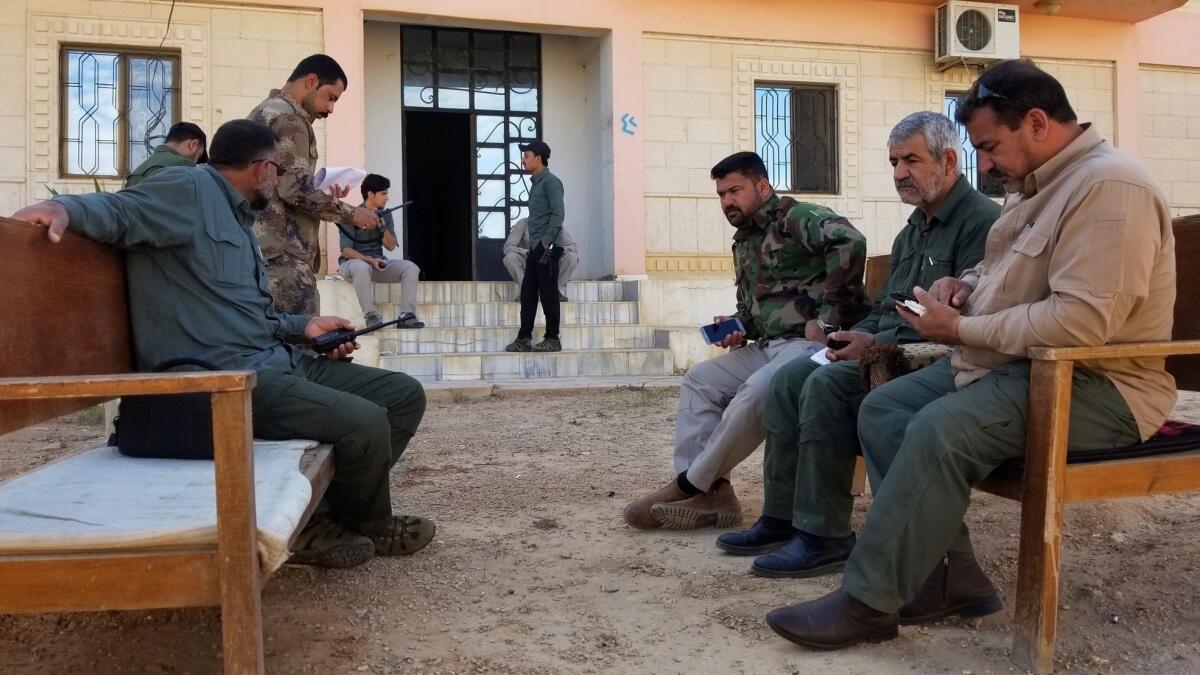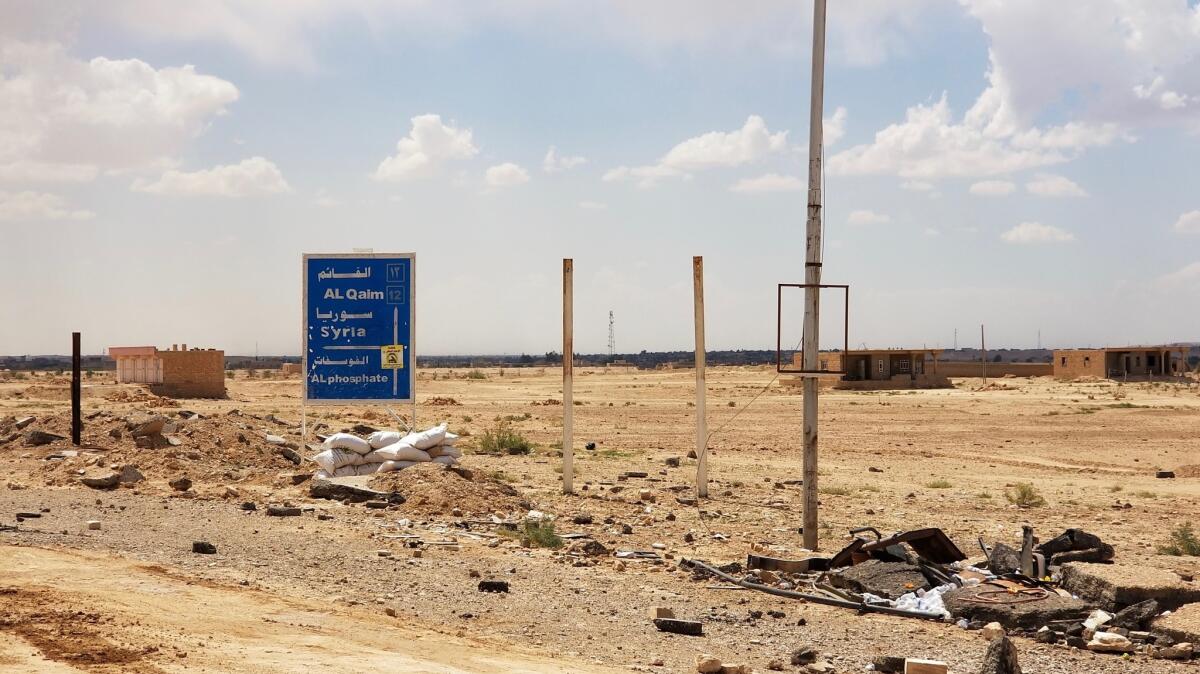It’s an awkward dance as the U.S., Russia and Iran all zero in on Islamic State

- Share via
Reporting from Qaim, Iraq — Here on the banks of the Euphrates River, children play, as they have for centuries, on frond-laced banks, watching fishing boats cut through the placid water. Nearby, farmers plant crops in lush bottomlands.
The bucolic setting belies the complex battle of influence raging nearby.
Islamic State militants are hunkered down a few miles away in their last refuge: the desert hinterlands straddling the Iraq-Syria border. A splintered array of countries, including the United States, Russia and Iran, are trying to defeat them once and for all. But that goal is complicated by deep mistrust and geopolitical rivalries.
Last month, the United States launched “Operation Roundup,” an offensive aimed at dislodging Islamic State from the Baghouz mountains, a triangular slice of territory wedged between the eastern bank of the Euphrates and the two countries’ border.
The assault is led by an alliance of Syrian Kurdish and Arab militias that is the vanguard of Western efforts to destroy Islamic State in Syria. It is part of a larger campaign to remove the militants from Syria’s oil-rich province of Dair Alzour and seal them off from Iraq’s Anbar province.
The effort has drawn U.S., French and Italian commandos to fight alongside the Kurds. The skies are filled with the shriek of coalition aircraft and Iraqi F-16s on their way to strike Islamic State positions.

On the Iraqi side of the border in Qaim, the coalition coordinates uneasily with Iraqi Shiite factions — groups known collectively as the Popular Mobilization Forces, which have a strong loyalty to Iran.
Just across the Euphrates lies the Syrian city of Bukamal. There, the Syrian army is conducting its own fight against Islamic State, bolstered by Russian mercenaries, Iranian Revolutionary Guard advisors and Iranian-backed irregulars from Lebanon, Iraq and Afghanistan. They too have air power: Russian warplanes and Iranian drones.
On the surface, all sides have the same goal: to defeat Islamic State. But in reality, each has a larger aim.
The U.S. wants the Kurds to cement their control over eastern Syria, fashioning their enclave into an alternative to the rule of Syrian President Bashar Assad.
With its proxies in control, the U.S. would gain stewardship of the Iraq-Syria border, using it to block Iran’s growing influence in the region.
Many contend that the Iranians seek to establish a land bridge linking Tehran to the Mediterranean. With other parts of the Syrian-Iraqi border in coalition hands, the Bukamal-Qaim crossing is the last available access point.
Assad, meanwhile, has routinely vowed to retake every inch of Syria. And both he and his Russian backers need the resource-rich area held by the Kurds for fuel and agriculture.
Amid them all sits Islamic State, whose militants (estimates say they number anywhere from 800 to a couple thousand) have burrowed tunnels and other hiding places deep in the desert, and thrive in the fault lines between the various spheres of control.
It wouldn’t be the first time the region has served as the militants’ last refuge.
For decades, the border crossing and the surrounding desert areas were a smugglers’ haven between Iraq and Syria. After the U.S. invasion in 2003, Al Qaeda took over, later morphing into Islamic State.
Then, amid the maelstrom of the Syrian civil war, Islamic State snatched control of Bukamal and Qaim in 2014. It claimed to have obliterated the “lines on a map” drawn by colonial powers a century ago, and declared a “caliphate” in the region.
By 2015, it had captured the full 372-mile length of the Iraq-Syria border.
But as the caliphate crumbled, the United States and Russia wielded proxies like chess pieces to outflank each other.
Since then, a tense stalemate has developed, with rival forces suspiciously eyeing one another for any advance. Over the last year, clashes have broken out between Iranian-backed factions and the U.S.; one skirmish in February left hundreds of pro-Syrian government forces and Russian mercenaries killed.
Yet beyond a “deconfliction line,” a communication link between the U.S. and Russia to inform each other of troop movements, there is no coordination between the groups, nor are they willing to work together to secure the area against Islamic State.
“This is the problem. ISIS can run back and forth. It can hide,” said Joshua Landis, director of the Center for Middle East Studies at the University of Oklahoma, using an acronym for the group.
Indeed, the various sides in the U.S. and Russian camp go so far as to accuse each other of foot-dragging, if not outright collaboration with the jihadis.
Maj. Gen. Felix Gedney, a British commander with the U.S.-led coalition, said in a Pentagon news briefing in May that Syrian pro-government forces “seem either unwilling or unable to effectively deal” with Islamic State.
The Syrians say much the same about the Americans.
“We are the main party who’s been fighting ISIS with support by the Russians and Iranians during the past years,” said Assad in an interview with the Mail on Sunday this month.
“If you want to talk about the West and the Western military alliance led by the Americans, actually it has been supporting ISIS, because they’ve been attacking the Syrian army whenever we attack or we’ve been attacked by ISIS.”
It’s an assessment that would find support from some of the U.S.’ supposed allies on the Iraqi side of the border, such as Hajj Qassem Musleh, a commander with the Popular Mobilization Forces who insists the U.S. has obstructed his forces’ plans to finish off the jihadis.
In the often-contradictory taxonomy by which the U.S. classifies friend and foe in its battle against Islamic State, Musleh is both.
His fighters, along with thousands of other Popular Mobilization Forces irregulars, have seized control of positions along the Iraqi side of the border, including Qaim.
Ostensibly he fights on the same side as the Americans to secure the Iraqi side of the border. But his weapons are Iranian, and an Iranian advisor is embedded with his men.
And once Musleh crosses into Syria, he fights alongside the Iranians. At that point, he is a U.S. enemy.
As for Iran? “Whether [the] U.S. or Israel likes it or not,” said Musleh in an interview at his headquarters in Qaim, “it is the master of the Middle East and the most effective power.”
With Islamic State still a stone’s throw away, Qaim is a city hobbling to right itself even as residents warn of jihadi sleeper cells in their midst.
Beyond security matters, the electric grid is wrecked (Islamic State toppled dozens of transmission towers to steal copper wires); medical centers and schools remain woefully understaffed; and there is little money for much-needed reconstruction.
Without reconstruction and the building of a viable economy, said Landis, “they’re never going to get rid of ISIS, because ISIS breeds on a lack of a state.”
And with the various powers arrayed against each other, the shared interests in working together and coordinating to prevent Islamic State’s return aren’t there.
That, said Landis, means the area would remain the Islamic State haven it always has been.
The militant group is going to be able to outmaneuver the two main sides working there, he continued, “because neither of them have an answer for this region.”
Bulos is a special correspondent.
Twitter: @nabihbulos
More to Read
Sign up for Essential California
The most important California stories and recommendations in your inbox every morning.
You may occasionally receive promotional content from the Los Angeles Times.











